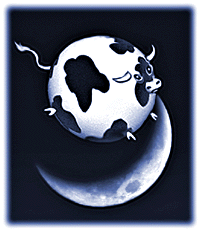Spherical cow

The spherical cow is a
The metaphor and variants have subsequently been used in other disciplines.
History
The phrase comes from a joke that spoofs the simplifying assumptions sometimes used in theoretical physics.[5]
Milk production at a dairy farm was low, so the farmer wrote to the local university, asking for help from academia. A multidisciplinary team of professors was assembled, headed by a theoretical physicist, and two weeks of intensive on-site investigation took place. The scholars then returned to the university, notebooks crammed with data, where the task of writing the report was left to the team leader. Shortly thereafter the physicist returned to the farm, saying to the farmer, "I have the solution, but it works only in the case of spherical cows in a vacuum."
It is told in many variants,[6] including a joke about a physicist who said he could predict the winner of any race provided it involved spherical horses moving through a vacuum.[7][8] A 1973 letter to the editor in the journal Science describes the "famous story" about a physicist whose solution to a poultry farm's egg-production problems began with "Postulate a spherical chicken".[9]
Cultural references


The concept is familiar enough that the phrase is sometimes used as shorthand for the entire issue of proper modeling. For example, Consider a Spherical Cow is a 1988 book about problem solving using simplified models.
References to the joke appear even outside the field of scientific modeling. "Spherical Cow" was chosen as the code name for the
See also
- Assume a can opener, a joke about invalid assumptions in economics
- Amorphous globosus, a rare and fatal birth defect in cattle, producing a ball of underdeveloped tissue
- Fermi problem, efforts to produce very broad estimates
- Homo economicus, a hypothetical rational person
- Naïve physics, also called folk physics
- Schwarzschild metric, an exact solution of the Einstein field equations assuming a uniform spherical symmetric nonrotating uncharged mass in a vacuum
References
- ^ Shelton, Robin; Cliffe, J. Allie. "Spherical Cows". Supernova Remnant Group. NASA Goddard Space Flight Center. Archived from the original on 9 October 1999.
- ^ Kaiser, David (2014-04-25). "The Sacred, Spherical Cows of Physics". Nautilus Quarterly.
- . Retrieved 2023-04-27.
- ISSN 1059-1028. Retrieved 2023-04-27.
- ^ Lee, Timothy B. (September 4, 2013). "The Coase Theorem is widely cited in economics. Ronald Coase hated it". The Washington Post.
- ^ Kirkman, T. W. (1996). "Spherical Cow: A Simple Model". Statistics to Use. Retrieved 2007-02-19.
- ISBN 978-0-387-76577-8. Retrieved 28 September 2011.
- ISBN 978-3-642-00482-7. Retrieved 1 September 2012.
- S2CID 29103654. Retrieved 18 Feb 2017.
- ISBN 978-0-935702-58-3.
- . Retrieved 6 December 2022.
- ^ Larabel, Michael (2012-05-01). "Fedora 18 Is Codenamed The Spherical Cow". Phoronix. Retrieved 2023-06-06.
- ^ Huva, Amy. "When nerds go viral". Earth Matters. The Vancouver Observer. Archived from the original on 2019-12-05.
- ^ "A Comet, an Asteroid, and a Planet Walk into the Solar System | Update 32.2". Universe Sandbox. 2023-03-23. Retrieved 2023-03-27.
External links
- NASA:Exploration of the Universe Division - Supernova models as spherical cows
- Hubble Heritage Gallery Page: related history from Space Telescope Institute
